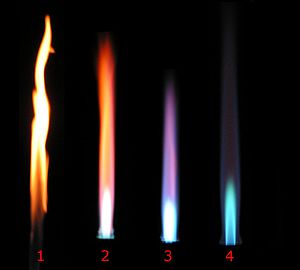
Oxidizing and reducing flames
Encyclopedia



Burner
Burner may refer to:* Gas burner or oil burner, a mechanical device that burns a gas or liquid fuel into a flame in a controlled manner* Hot-air balloon device, a device to inflate a hot air balloon* Burner * Burner, West Virginia...
s, the oxidizing flame is a flame
Flame
A flame is the visible , gaseous part of a fire. It is caused by a highly exothermic reaction taking place in a thin zone...
produced with an excessive amount of oxygen
Oxygen
Oxygen is the element with atomic number 8 and represented by the symbol O. Its name derives from the Greek roots ὀξύς and -γενής , because at the time of naming, it was mistakenly thought that all acids required oxygen in their composition...
. A flame with a good balance of oxygen is clear blue. When the amount of oxygen increases, the color darkens, the flame shortens, and it hisses and roars. With some exceptions (e.g., soldering
Soldering
Soldering is a process in which two or more metal items are joined together by melting and flowing a filler metal into the joint, the filler metal having a lower melting point than the workpiece...
of platinum
Platinum
Platinum is a chemical element with the chemical symbol Pt and an atomic number of 78. Its name is derived from the Spanish term platina del Pinto, which is literally translated into "little silver of the Pinto River." It is a dense, malleable, ductile, precious, gray-white transition metal...
, in jewelry), the oxidizing flame is undesirable in welding
Welding
Welding is a fabrication or sculptural process that joins materials, usually metals or thermoplastics, by causing coalescence. This is often done by melting the workpieces and adding a filler material to form a pool of molten material that cools to become a strong joint, with pressure sometimes...
and soldering, since, as the name suggests, it oxidizes the surface of the metal
Metal
A metal , is an element, compound, or alloy that is a good conductor of both electricity and heat. Metals are usually malleable and shiny, that is they reflect most of incident light...
.
The reducing flame is the flame low in oxygen. It has a yellow or yellowish color due to elements (typically carbon
Carbon
Carbon is the chemical element with symbol C and atomic number 6. As a member of group 14 on the periodic table, it is nonmetallic and tetravalent—making four electrons available to form covalent chemical bonds...
or hydrocarbon
Hydrocarbon
In organic chemistry, a hydrocarbon is an organic compound consisting entirely of hydrogen and carbon. Hydrocarbons from which one hydrogen atom has been removed are functional groups, called hydrocarbyls....
s) which would bind ("reduce") with the oxygen contained in the materials processed with the flame. The reducing flame is also called the carburizing flame, since this flame tends to introduce carbon into the molten metal.
The neutral flame is the flame in which the amount of oxygen is only enough for burning, and neither oxidation nor reduction occurs.
The reducing or neutral flame is useful in soldering and annealing
Annealing (metallurgy)
Annealing, in metallurgy and materials science, is a heat treatment wherein a material is altered, causing changes in its properties such as strength and hardness. It is a process that produces conditions by heating to above the recrystallization temperature, maintaining a suitable temperature, and...
.
See also
- Oxy-fuel welding and cutting#Types of flame for further details about the above types of flame in oxy-fuel burners

